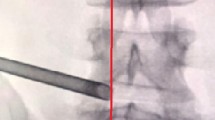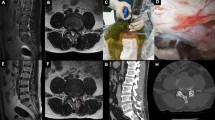Abstract
Earlier studies have compared transtubular discectomy with microsurgical discectomy in the treatment of lumbar disc herniations, but a few prospective studies with homogeneous groups of patients have been conducted. The aim of this study was to compare intraoperative and immediate postoperative results in a group of patients submitted to discectomy with the use of a tubular retractor (TTD) to the one operated with standard microdiscectomy as described by Caspar (MSD). A total of 83 patients were prospectively observed and reviewed. Two homogeneous groups of patients were compared. All patients were preoperatively examined by the operating surgeon and the anaesthesiologist. All surgical data and constatations were collected on the operative summary. Several parameters like operative time, morphinic consumption in recovery room, length of hospital stay and peri- and post-operative complications were compared. Results show that both procedures lead to excellent recovery and that TTD is a viable alternative to MSD. There was no statistically significant difference in most of the examined parameters between the two techniques.




Similar content being viewed by others
References
Mixter WJ, Barr JS (1934) Rupture of intervertebral disc with involvement of the spinal canal. N Engl J Med: 210–215
Love J (1939) Removal of protruded intervertebral disc without laminectomy. Proc Staff Meet Mayo Clinic 14:800
Caspar W (1977) A new surgical procedure for lumbar disc herniation causing less tissue damage through a microsurgical approach. In: Wullenweber R, Brock M, Hamer J (eds) Advances in neurosurgery. Springer, Berlin, pp 74–77
Yasargil MG (1977) Microsurgical operation of herniated disc. In: Wullenweber R, Brock M, Hamer J (eds) Advances in neurosurgery. Springer, Berlin, p 81
Foley KT, Smith MM (1999) Microendoscopic discectomy. Tech Neurosurg 3:301–307
Perez-Cruet MJ, Foley KT, Isaacs RE et al (2002) Microendoscopic lumbar discectomy: technical note. Neurosurgery 51(Suppl 2):129–136
Righesso O, Falavigna A, Avanzi O (2007) Comparison of open discectomy with microendoscopic discectomy in lumbar disc herniations: results of a randomized controlled trial. Neurosurgery 6:545–549
Ryang YM, Oertel MF, Mayfrank L et al (2007) Standard open microdiscectomy versus minimal access trocar microdiscectomy: results of a prospective randomized study. Neurosurgery 61:174–182
Schizas C, Tsiridis E, Saksena J (2005) Microendoscopic discectomy compared with standard microsurgical discectomy for the treatment of uncontained or large contained disc herniations. Neurosurgery 57(ONS suppl 3):357–360
Toyone T, Tanaka T, Kato D et al (2004) Low-back pain following surgery for lumbar disc herniation. A prospective study. J Bone Joint Surg Am 86:893–896
Awad JN, Moskovich R (2006) Lumbar disc herniations. Surgical versus nonsurgical treatment. Clin Orth Rel Res 443:183–197
Arts MP, Nieborg A, Brand R et al (2007) Serum creatine phosphokinase as an indicator of muscle injury after various spinal and non-spinal surgical procedures. J Neurosurg Spine 7:282–286
Kotil K, Tunckale T, Tatar Z et al (2007) Serum creatine phosphokinase activity and histological changes in multifidus muscle: a prospective randomized controlled comparative study of discectomy with or without retraction. J Neurosurg Spine 7(3):121–125
Sasaoka R, Nakamura H, Konishi S et al (2006) Objective assessment of reduced invasiveness in MED compared with one level laminotomy. Eur Spine J 15:577–582
Kawagushi Y, Matsui H, Tsuji H (1996) Back muscle injury after posterior lumbar spine surgery. A histologic and enzymatic analysis. Spine 21:941–944
Wu X, Zhuang S, Mao Z et al (2006) Microendoscopic discectomy for lumbar disc herniation. Surgical technique and outcome. Spine 31(23):2689–2694
Cole JSIV, Jackson TR (2007) Minimally invasive lumbar discectomy in obese patients. Neurosurgery 61:539–544
Park P, Upadhyaya C, Garton HJL et al (2008) The impact of minimally invasive spine surgery on perioperative complications in overweight or obese patients. Neurosurgery 62:693–699
Isaacs RE, Podichetty V, Fessler RG (2003) Microendoscopic discectomy for recurrent disc herniations. Neurosurg Focus 15(3):E11
Holly LT, Schwender JD, Rouben DP et al (2006) Minimally invasive transforaminal lumbar interbody fusion: indications, technique, and complications. Neurosurg Focus 20(3):E6
Mummaneni P, Rodts GE Jr (2005) The mini-open transforaminal lumbar interbody fusion. Neurosurgery 57:256–261
Schwender JD, Holly LT, Rouben DP et al (2005) Minimally invasive transforaminal lumbar interbody fusion (TLIF): technical feasibility and initial results. J Spinal Disord Tech 18 Suppl:1–6
Conflict of interest statement
No funds were received in support of this study. No benefits of any form have been or will be received from a commercial party related directly or indirectly to the subject of this manuscript.
Author information
Authors and Affiliations
Corresponding author
Rights and permissions
About this article
Cite this article
Bennis, S., Scarone, P., Lepeintre, JF. et al. Transtubular versus microsurgical approach for single lumbar disc herniation: a prospective study. Eur J Orthop Surg Traumatol 19, 535–540 (2009). https://doi.org/10.1007/s00590-009-0478-y
Received:
Accepted:
Published:
Issue Date:
DOI: https://doi.org/10.1007/s00590-009-0478-y




